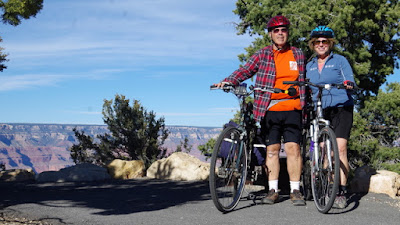Having spent over 3 weeks in arid Arizona; Sedona and the fabulous red rock formations, the Saguaros with their arms and nubs, the great hikes to surprising springs and tanks, and the temperatures hitting 90 degrees.....It was now time to head to pine trees and cooler temps. And, our plans to go to Chiracahua National Monument (one of our favorite parks) were besmirched when we received a message that the roads to the hiking trails were closed .
So what did we do??
The Grand Canyon was calling us... "Come Visit, the temps are perfect, and the views are sublime." So we changed our plans and bee lined; well actually moseyed to the Canyon.
First stop after spending a night at a National Forest campground with pine trees; (no cactus)
was Tonto Natural Bridge State Pa

rk. Found this gem of a park on our AAA map. Here is the
largest travertine arch in the world!
After a 14% grade to get down to the bridg

e, and passing the flowering trees, we hiked to the Bridge.
WOW !
BIW had no problem climbing the 14% to continue our journey....Remember, the Canyon is Calling.......So no delays allowed.
Now to the Grand Canyon. Spent the first two nights at the Trailer Ranch campground with full hookups....so we could watch the Super Tuesday primaries, and prepare for our upcoming dry camping. Our first stop when we arrived at the National Park was the Visitor Center and then a walk to the Rim. The Canyon is as awe inspiring as ever!
Our first full day, we mounted our bikes and headed to Hermits Rest. Did this four years ago, and it was even better than remembered. One great view after another. After the 20 mile ride, including some 6% grades, we are tired but exhilarated. More Canyon to come before we move on.
 Covered 500 miles today with BIW. Smooth driving through Arkansas and Tennessee along Interstate 40. Enjoyed the blue skies, the redbuds in bloom, the green plants, and the rocks.
Covered 500 miles today with BIW. Smooth driving through Arkansas and Tennessee along Interstate 40. Enjoyed the blue skies, the redbuds in bloom, the green plants, and the rocks.










































